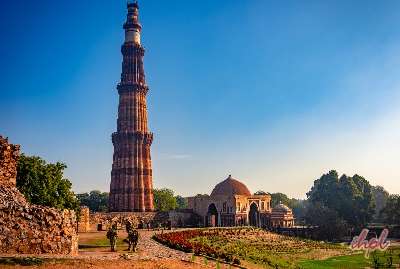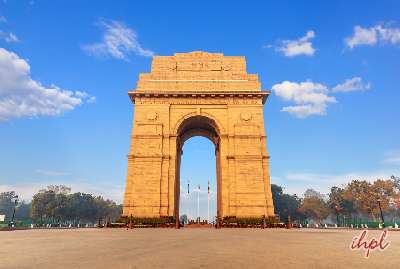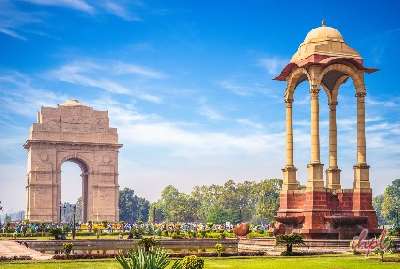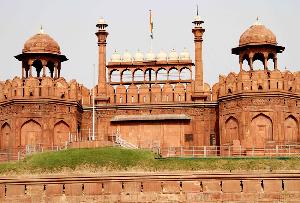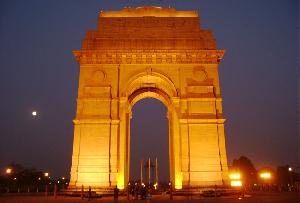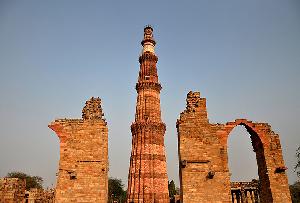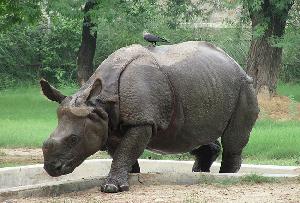Jantar Mantar built by Sawai Jai Singh II is an example of the scientific advancements of medieval India. Constructed in 1724, this structure lies at the heart of the city as a symbol of the technological strides of the Rajput dynasty. Jai Singh built four such observatories in Jaipur, Ujjain, Mathura and Varanasi.
During Muhammad Shah’s rule, the Hindu and Muslim astrologers were involved in an unending discussion about the planetary positions. They wanted to determine an auspicious hour for the king’s expedition. So Sawai Jai Singh decided to put an end to this issue by rectifying the astronomical tables.
This resulted in the construction of Jantar Mantar. So Jai Singh sent a mission to the King of Lisbon which brought back a telescope and an astronomer called Xavier De Silva. The Jantar Mantar in Delhi was set up inspired by the observatory in Samarkand.
There are different structures in different shapes in Jantar Mantar to measure the movement of the planetary bodies.
The vast red sloping structure in Jantar Mantar is the sundial or the Samrat Yantra. It is an equinoctial sun dial. The sundial cast the shadows which are used to calculate the time and the movement of planetary positions. The Misra Yantra can measure the shortest and longest day of the year. Besides this there is the Ram Yantra and the Jay Prakash Yantra meant to monitor the movement of celestial bodies.
The Jantar Mantar is therefore a reflection of the rational mind of Indians which developed years ago.
Checkout: Delhi Tour Packages
History:
The history of Jantar Mantar traces the history of astronomical interest of India. The Jantar Mantar is an astronomical observatory in Delhi constructed by King Sawai Jai Singh II. Located in the bustling Sansad Marg, the Jantar Mantar is another example of the scientific achievements of ancient India.
Constructed in the year 1724, the observatory was the result of Sawai Jai Singh’s passion for astronomy related subjects. It was called the Yantra Mantra. Jai Singh built four other such observatories in Jaipur, Ujjain, Mathura and Varanasi.
Jantar Mantar was created to monitor movements of the celestial bodies. It consists of different abstract structures which were used to know the deepest secrets of the universe.
During the reign of Muhammad Shah, the Hindu and Muslim astrologers were involved in brainstorming debate about certain planetary positions. So to put an end to that and also to determine the most auspicious hour for the emperor’s expedition, Sawai Jai Singh decided to rectify the astronomical tables. This resulted in the construction of Jantar Mantar
The vast red sloping structure in the Jantar Mantar is the sundial which is known as the Samrat Yantra. It is an equinoctial sun dial. The sundial casts the shadows to calculate the time and the movement of planetary positions. There is a Misra Yantra which has a number of functions and it can also measure the shortest and longest day of the year.
Besides this, the Ram Yantra and the Jay Prakash Yantra were meant to monitor the movement of celestial bodies.
Fast – Facts:
Location:
It is located in Parliament Street in Connaught Place.
History:
It was built by Sawai Jai Singh II.
Architecture:
It is an astronomical observatory which consists of different structures in sandstone to calculate the movement of celestial bodies and the planetary positions.
How to Reach:
The tourists can take auto rickshaws, taxis, buses or the Metro Rail to reach Connaught Place. Jantar Mantar is located in Connaught Place.
Attractions:
Astronomical shows are organized yearly where you can get to know about the planets and their position.
Charges for Photography: Video filming Charges are INR 25
Nearest Shopping Venues:
- Connaught Place
- Janpath
- Palika Bazaar
- Central Cottage Industries Emporium
Nearest Metro Station: Connaught Place
Nearest Airport: Indira Gandhi International Airport
Nearest Railway Station: New Delhi Railway Station
Nearby Attractions:
Jantar Mantar is an astronomical observatory, built by Sawai Jai Singh II. The tourists who visit Jantar Mantar also visit the nearby attractions of Jantar Mantar. The Jantar Mantar built in 1724 reflects the rational and curious mind of the Indians and their thirst for scientific knowledge. In the 18th century this observatory stands as a proof of the nascent scientific achievements of India. The other Jantar Mantar is located in Jaipur, Varanasi, Ujjain and Mathura.
Tourist Places near Jantar Mantar:
Rashtrapati Bhawan:
The majestic Rahtrapati Bhawan which is the residential mansion of the Indian President still reflects the glory and grandeur of British era. With its vintage charm and architectural splendor, the Rashtrapati Bhawan takes us back to the British era.
India Gate:
dedicated to the Indian soldiers who lost their lives, this 42m high arch overlooks the city of Delhi. The eternally burning flame beneath the arch keeps alive the patriotism of our countrymen.
Gurudwara Bangla Sahib:
located in New Delhi, this is the most prominent place of worship for the Sikhs in Delhi. Earlier a bungalow of Jai Singh, this is now a shrine dedicated to Guru Har Krishan.
Hanuman Mandir:
Originally it dates back to the time of Raja Jai Singh and this Hanuman Mandir is of special importance to the residents of Delhi.




